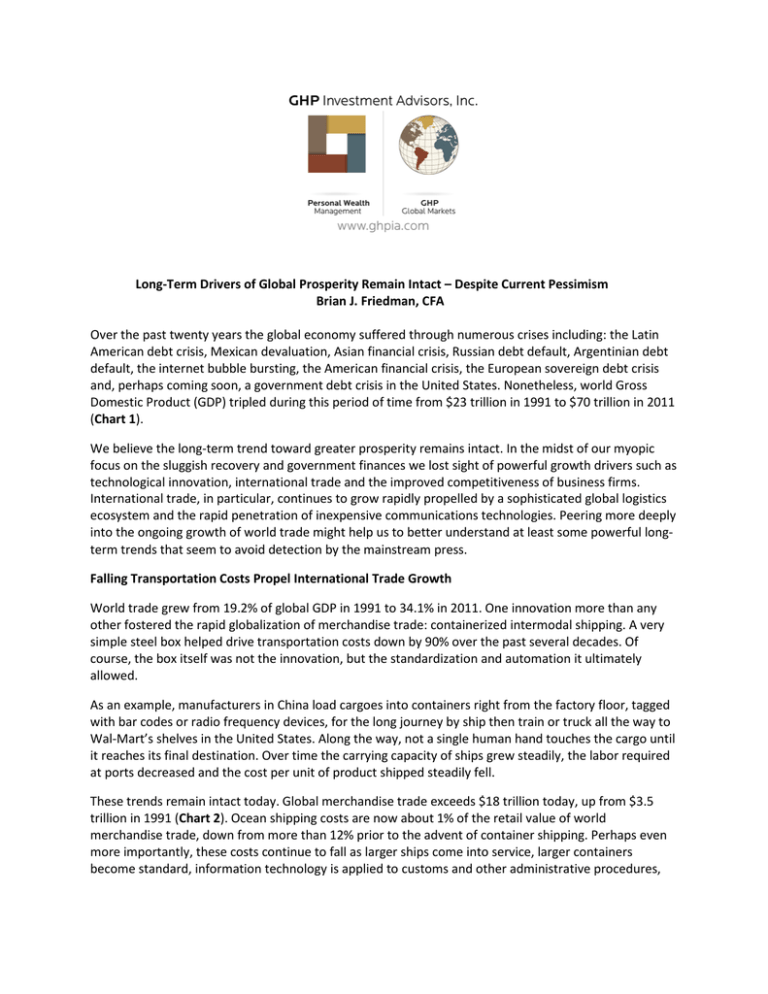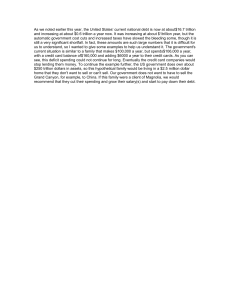Long-Term Drivers of Global Prosperity Remain Intact – Despite
advertisement

Long-Term Drivers of Global Prosperity Remain Intact – Despite Current Pessimism Brian J. Friedman, CFA Over the past twenty years the global economy suffered through numerous crises including: the Latin American debt crisis, Mexican devaluation, Asian financial crisis, Russian debt default, Argentinian debt default, the internet bubble bursting, the American financial crisis, the European sovereign debt crisis and, perhaps coming soon, a government debt crisis in the United States. Nonetheless, world Gross Domestic Product (GDP) tripled during this period of time from $23 trillion in 1991 to $70 trillion in 2011 (Chart 1). We believe the long-term trend toward greater prosperity remains intact. In the midst of our myopic focus on the sluggish recovery and government finances we lost sight of powerful growth drivers such as technological innovation, international trade and the improved competitiveness of business firms. International trade, in particular, continues to grow rapidly propelled by a sophisticated global logistics ecosystem and the rapid penetration of inexpensive communications technologies. Peering more deeply into the ongoing growth of world trade might help us to better understand at least some powerful longterm trends that seem to avoid detection by the mainstream press. Falling Transportation Costs Propel International Trade Growth World trade grew from 19.2% of global GDP in 1991 to 34.1% in 2011. One innovation more than any other fostered the rapid globalization of merchandise trade: containerized intermodal shipping. A very simple steel box helped drive transportation costs down by 90% over the past several decades. Of course, the box itself was not the innovation, but the standardization and automation it ultimately allowed. As an example, manufacturers in China load cargoes into containers right from the factory floor, tagged with bar codes or radio frequency devices, for the long journey by ship then train or truck all the way to Wal-Mart’s shelves in the United States. Along the way, not a single human hand touches the cargo until it reaches its final destination. Over time the carrying capacity of ships grew steadily, the labor required at ports decreased and the cost per unit of product shipped steadily fell. These trends remain intact today. Global merchandise trade exceeds $18 trillion today, up from $3.5 trillion in 1991 (Chart 2). Ocean shipping costs are now about 1% of the retail value of world merchandise trade, down from more than 12% prior to the advent of container shipping. Perhaps even more importantly, these costs continue to fall as larger ships come into service, larger containers become standard, information technology is applied to customs and other administrative procedures, intermodal transfers to trucks and rail are automated, and developing countries invest in transportation and port infrastructure. Average global shipping costs are unlikely to fall another 90%, but steady improvements in productivity and cost will continue to support merchandise trade growth. Meanwhile many countries are only now starting to reap the benefits of cost effective international shipping by investing in the appropriate infrastructure to join the global logistics ecosystem. India, with a population of 1.2 billion, is perhaps the best example of a laggard country only now starting to build the modern roads and ports necessary to connect with the global economy. The Internet – Starting to Live Up to the 1990’s Hype The next great revolution in international commerce is already underway. Global trade in services increased from $827 billion in 1991 to $4.2 trillion in 2011 (Chart 2). The internet and telecommunications networks are driving down the “shipping costs” of information, software and services, thereby allowing inexpensive access to the global marketplace for many businesses around the world. Mobile apps, securities trading, architectural drawings, engineering services, and x-ray analysis are just a few examples of the growing global trade in services. We are only just now starting to live up to the exaggerated hype of the 1990’s internet bubble. For example, only 10 years ago less than 25% of the world’s population had access to a cell phone. Today cell phones are nearly ubiquitous (Chart 3). In 2003, Internet penetration in developed economies such as the U.S., Europe and Japan was only 50% and less than 5% in middle and low income countries. Today, almost everyone in the developed world uses the internet (except perhaps for very small children, but even that is growing) and internet usage in developing countries is growing very rapidly. Driving further growth in the coming decade will be the shift away from “dumb” cell phones with limited data capabilities toward “smart” phones as well as plunging prices for broadband internet access in developing countries. Prosperity Relies on Many Factors, Not Just Good (or Bad) Government Policies Over the years the world built a sophisticated global logistics ecosystem which radically reduced merchandise shipping costs. Along the way, global just-in-time manufacturing and big box retailers delivered price competition to consumers with an increased variety of products on the shelves. Now the internet is facilitating global trade in services along a similar declining cost curve which will likely last for many years to come. As a consequence, the magnitude of world trade will continue to deeply impact investments, jobs and incomes. For some people, of course, the effects will be negative, but for the majority prosperity will continue its global spread. Although government deficits and debt must be addressed and will contribute to economic growth or recessions, they are not the entire story. Chart 1 World Gross Domestic Product (GDP) ( $ Billions ) 1991 1992 1993 1994 1995 1996 1997 1998 1999 2000 2001 2002 2003 2004 2005 2006 2007 2008 2009 2010 2011 $80,000 $70,000 $60,000 $50,000 $40,000 $30,000 $20,000 $10,000 $0 Chart 2 $20,000,000 $15,000,000 Merchandise $10,000,000 Services $5,000,000 Chart 3 8.0 World Population 7.0 6.0 Mobile Phone Subscriptions 5.0 4.0 3.0 2.0 1.0 0.0 2003 2004 2005 2006 2007 2008 2009 2010 2011 2012 2011 2010 2009 2008 2007 2006 2005 2004 2003 2002 2001 2000 1999 1998 1997 1996 1995 1994 1993 1992 1991 $0


